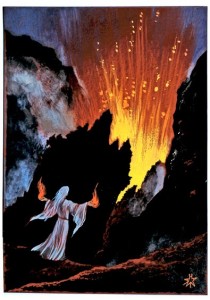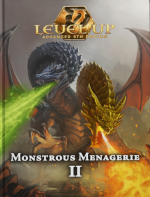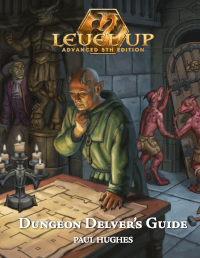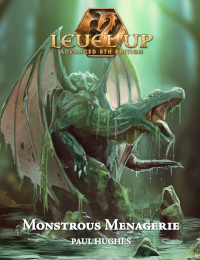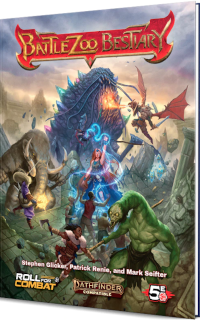Looking at fifth edition Basic’s pared-down, classic-heavy spell list, I thought, “What if these were all the widely known spells in the whole campaign world? What kind of game world is implied by the missing spells?”
Let’s say that, when PCs level up, they can automatically learn spells only from the Basic list. Everything in the Players Handbook, and in all future splatbooks, exists somewhere in the world, but it’s hidden in some way. Wish is scribed in a moldering book in the dungeons of an empire past; Rary’s Mnemonic Enhancer is known only by the lich that was once Rary; the one guy who knows Wall of Fire lives inside a fiery labyrinth; and no one knows Explosive Runes at all, and a PC wizard will have to invest research time to learn it. Capturing a wizard’s spellbook is an exciting opportunity to find an otherwise unobtainable spell. Rare cleric spells are taught in hidden monasteries or granted in dreams by angels.
To me, this sounds good in theory, and it will work or not depending on the completeness of the Basic spell list. What’s the implied setting of this “Fifth Age” D&D world? Is its evocation- and healing-heavy spell list robust enough to outfit the majority of NPCs?
I’ll compare the spell list, rather arbitrarily, with magic-user and cleric spell lists in the 1e PHB. What spells are missing from the Fifth Age that existed in the influential implied setting of 1e Greyhawk?
I’ve organized the missing spells into a few categories:
Mechanical spells: I’m going to ignore 1e spells that operate on the game rules. Some missing 1e spells rely on on game mechanics that have changed: Read Magic and Write aren’t needed in 5e because the spellcasting rules have changed. Some spells add numbers to other numbers: 1e Strength makes people stronger, but it doesn’t change the possibilities open to characters. The NPCs can live without these just fine.
Marginal spells: Many of the 1e-only spells were never really very popular: Ventriloquism, Shatter, and Feign Death, for instance, were not really central to most people’s D&D experience, and their absence or rarity doesn’t make much of a dent on the implied setting. Others are variations or upgrades of more famous spells: while D&D needs Charm Person, it doesn’t rely on the existence of Charm Person AND Friends. There are dozens of spells like this that are quite appropriate as rare spells. Their existence is a rich source of exciting, or in some cases, puzzling treasure for spellcasters. “I’m the only person in the world who knows Feign Death! Now what do I do with it?”
Combat spells: 5e Basic has Magic Missile, Fireball, Lightning Bolt, Chain Lightning, and lots more classic direct-damage spells. Missing 1e combat spells include Flame Arrow, Enlarge, Otiluke’s Freezing Sphere, Fear, Cloudkill, and others. At some point, it doesn’t matter whether you blow up guys with a fireball or an iceball. The 5e Basic combat spell selection is more than adequate.
Construction spells: A surprising number of high-level 1e spells allow you to modify contructions, make temporary shelters, or trick out/trap out your castle: for instance, magic mouth, continual light, rope trick, Leomund’s tiny hut, dig, explosive runes, wall of fire, wall of ice, transmute rock to mud, wall of force, wall of iron, symbol, move earth. This tells us that 1e wizards had really nice fortresses and so did the monarchs they favored. For construction, 5e Basic has Wall of Stone. What does that tell us about the Fifth Age? Wizards may be able to summon curtain walls, but anything more complicated than that and they need to hire dwarven engineers. Wizards have no access to comfy extra-dimensional spaces (except Maze and Banishment, which are rarely comfy). As for furnishing lairs: no Continual Light, no traps, and no defenses except for Arcane Lock and Antimagic Field. Wizard towers are filled with guttering torches and patrolled by living guards, just like everyone else’s towers.
Summoning spells: 1e has Find Familiar, the Monster Summoning spells, Conjure Animal, Conjure Elemental, and Gate. Basic has Gate. None of my groups have made a big deal about summoning so I honestly don’t know if this matters to me.
Divination spells: There are some pretty powerful divination spells in 5e Basic (Arcane Eye, Locate Person, Divination, Commune) and the only defense is the high-level Antimagic Field. In this world, spying is easy and the only defense is counterspying. On the other hand, there’s no Know Alignment or Detect Lie. Scheming grand viziers can rest easy. Doppelgangers and succubi, however, might have to watch out for True Seeing.
No Water Breathing: It’s hard to explore the ocean. If you manage to research a Water Breathing spell, or find Kwalish’s Surprisingly Roomy Submarine, you’ll be able to loot underwater dungeons with no rivals except for monsters and merpeople. Barring that, no one knows what’s in the depths. Godzilla? Dreaming Chthulhu?
No Polymorph or Disguise Self: The abilities to magically change form, or even to disguise your form, are unknown to the arcane disciplines of 5e Basic. The thief reigns supreme as con artist. The best the wizard can do is turn invisible and cast Major Image.
No Animate Dead: For some reason, no one will teach you the Animate Dead spell. It’s like they don’t trust you or something. This one is a bit of a problem for the implied setting, because while PCs don’t really need access to Animate Dead, it’s hard to imagine a campaign world without a bunch of active necromancers stirring up bones.
High level spells: High level spells are rare in any campaign setting because high-level casters are rare. Still, the following absences are interesting: no one in the kingdom can necessarily control weather and guarantee good crops. Maybe some legendary druid can, if you can find her. (And no one can cast Create Food and Drink if the crops fail). Enchant Item and Permanency aren’t taught at wizard college; you’ll have to do your own magic-item research or find treasure in dungeons. You can’t make a backup of yourself with Clone: you might find this cool but peculiar spell as a strange relic of ancient technology in a dungeon. And high-level wizards can’t necessarily cast Wish once per day. They’ll need to find rings, lamps, and other relics, and hoard their wishes carefully.
What’s there: This description makes 5e Basic sound like a low-magic game, but plenty of spells are still being thrown around. What magical abilities are common? All sorts of ailments can be cured, including death. Clerics (but not wizards) can speak with the dead and conduct tours to the Ethereal and Astral Plane. Apart from their propensities to set everything on fire, wizards might be most feared for their ability to Charm, Suggest, and Dominate all and sundry. Long-distance teleportation is difficult (you need to be 15th level) but the air is thick with Flying fifth-level wizards.


